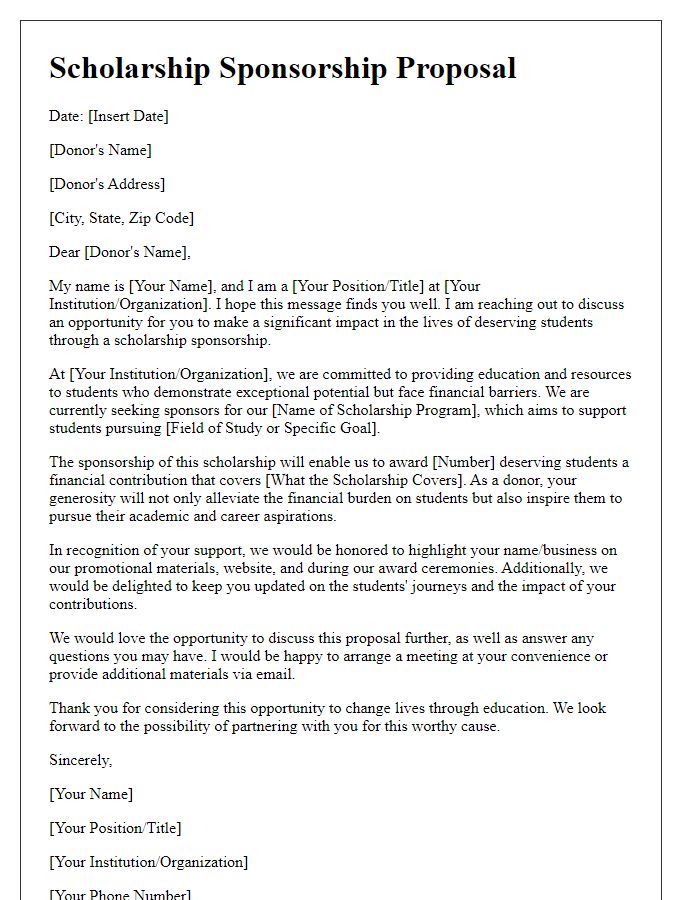Are you passionate about supporting the education of deserving students? We've crafted a compelling letter template that outlines a scholarship sponsorship proposal, making it easier for you to connect with potential sponsors. By presenting your vision clearly and attractively, you can inspire others to invest in the future of young scholars. Dive in to discover how to create a persuasive request that opens doors for students in need!

Clear mission statement
Developing a scholarship sponsorship proposal requires a clear mission statement that concisely conveys the purpose and goals of the initiative. The mission statement should reflect the commitment to support students' educational aspirations, foster diversity, and promote community engagement. For example, a mission statement could articulate the intent to provide financial assistance to underprivileged students pursuing degrees in STEM (Science, Technology, Engineering, Mathematics) fields at accredited universities. A focus on empowering the next generation of leaders through education and mentorship creates a compelling narrative that resonates with potential sponsors. The ultimate aim is to bridge the financial gap, ensuring that deserving candidates have the resources necessary to achieve academic and professional success.
Detailed project description
A scholarship sponsorship proposal aims to secure funding and support for educational opportunities for underserved students. The project focuses on providing financial assistance to high school graduates, particularly from low-income communities, aiming to enroll in accredited universities and vocational institutes across the United States. The initiative will provide scholarships that cover tuition fees, learning materials, and living expenses, enabling students to pursue degrees in high-demand fields such as engineering, healthcare, and information technology. The targeted demographic includes students from underrepresented backgrounds, with a goal to support at least 100 students in the first year, with anticipated outcomes including increased graduation rates and enhanced career prospects. The program's success will be monitored through regular surveys and interviews, ensuring that beneficiaries receive necessary academic support and mentorship programs.
Defined target audience or beneficiaries
Successful scholarship sponsorship proposals target specific audiences, focusing on underrepresented students in higher education. These beneficiaries often include low-income individuals, first-generation college students, or minorities pursuing degrees in fields like STEM (Science, Technology, Engineering, Mathematics). For example, a proposal could aim to support Hispanic students attending universities in California, where demographic representation is critical for diversity. By outlining key statistics, such as the nearly 50% of California's population identifying as Hispanic, the proposal emphasizes the importance of scholarship funding in promoting educational equity. Highlighting real-life stories from previous scholarship recipients can illustrate transformational impacts, showcasing how financial assistance can empower students to overcome obstacles and achieve academic success.
Benefits to the sponsor
The proposed scholarship sponsorship offers significant benefits to the sponsoring organization, enhancing its corporate image while promoting social responsibility. Engaging in educational support can result in positive public relations, showcasing commitment to community development and youth empowerment. By providing financial assistance to promising students, the sponsor solidifies its reputation as an advocate for education, appealing to consumer bases that value corporate citizenship. Additionally, sponsorship involvement yields networking opportunities with local educational institutions and increased visibility in community events, leading to potential partnerships. Recognition through branding on scholarship materials, events, and marketing communications can further expand reach and attract potential customers who prioritize businesses that invest in societal growth.
Detailed financial or resource needs
Scholarship sponsorship proposals require a clear and detailed financial assessment to ensure transparency and accountability. Annual tuition fees for universities, like Harvard or Stanford, can exceed $50,000, encompassing not only direct costs but also associated expenses such as textbooks, which may amount to an additional $1,200 per year, and living costs, averaging around $15,000 in urban areas. Furthermore, travel expenses for attending seminars and workshops, estimated at $500 per semester, contribute to the overall financial need. Scholarships targeting underrepresented groups might also consider specific resource needs, such as access to technology, with reliable laptops costing approximately $1,000, and software licenses that can add another $300 annually. Highlighting the overall budget, detailing the percentage of funding required from sponsors, and specifying any matching funds or support from community organizations can enhance the proposal's effectiveness, ensuring it meets the financial requirements necessary for academic success.
Letter Template For Scholarship Sponsorship Proposal Samples
Letter template of scholarship sponsorship request for educational institutions.

Letter template of scholarship sponsorship inquiry for non-profit organizations.

Letter template of scholarship sponsorship appeal for corporate sponsors.

Letter template of scholarship sponsorship application for community programs.

Letter template of scholarship sponsorship proposal for individual donors.

Letter template of scholarship sponsorship request for local businesses.

Letter template of scholarship sponsorship suggestion for alumni networks.

Letter template of scholarship sponsorship initiative for government grants.






Comments